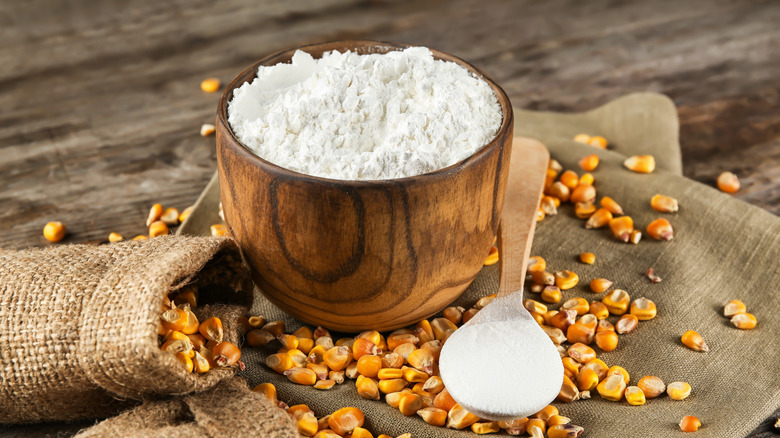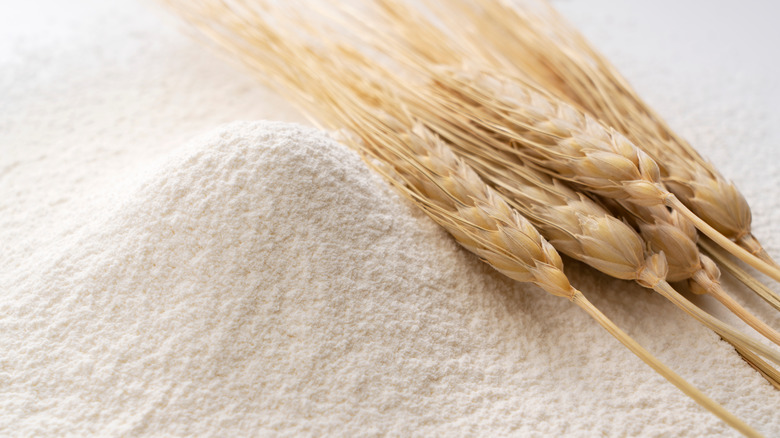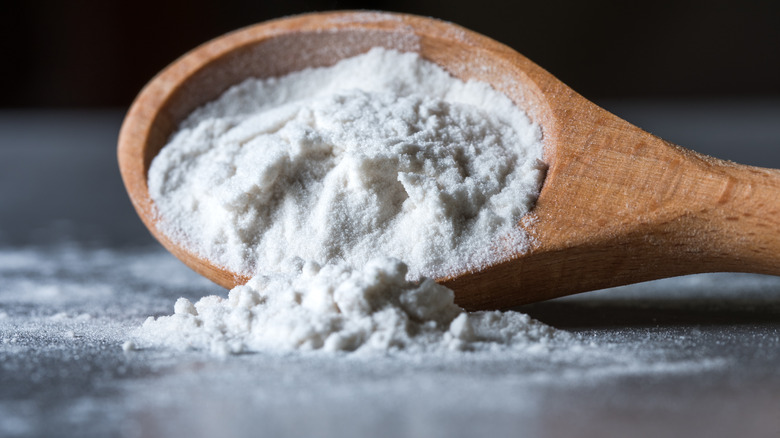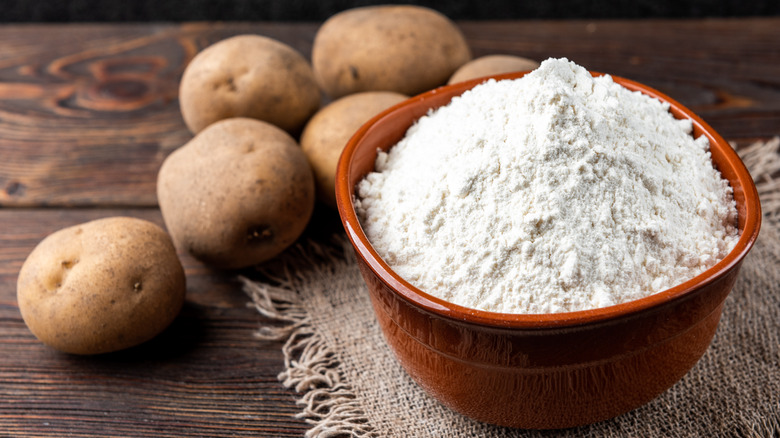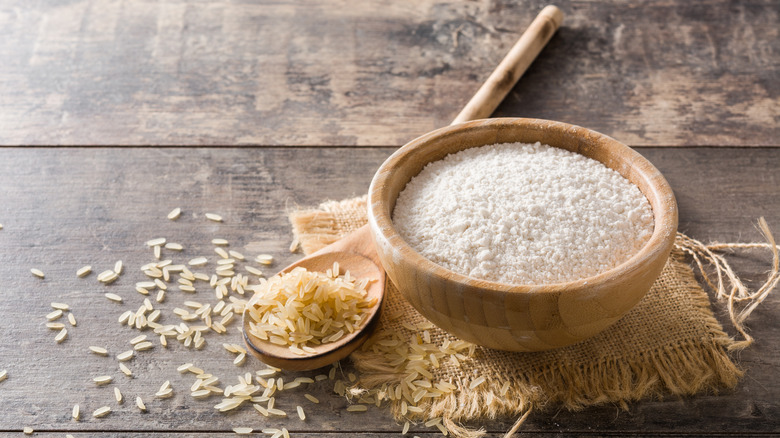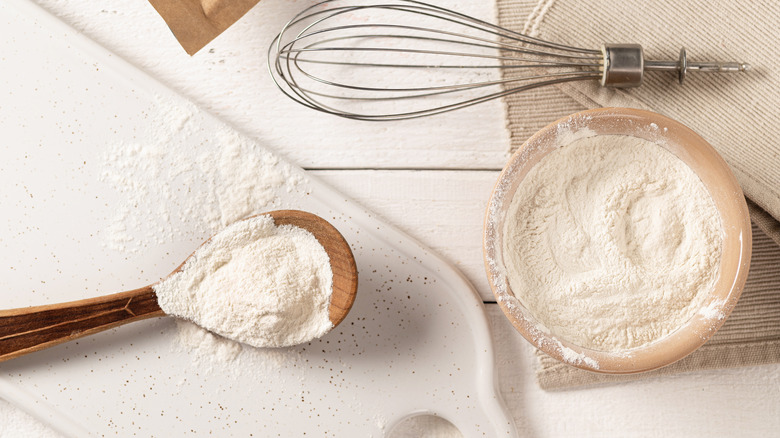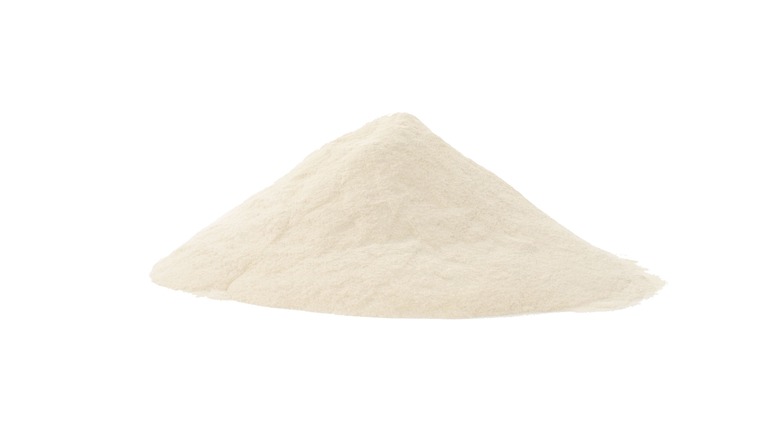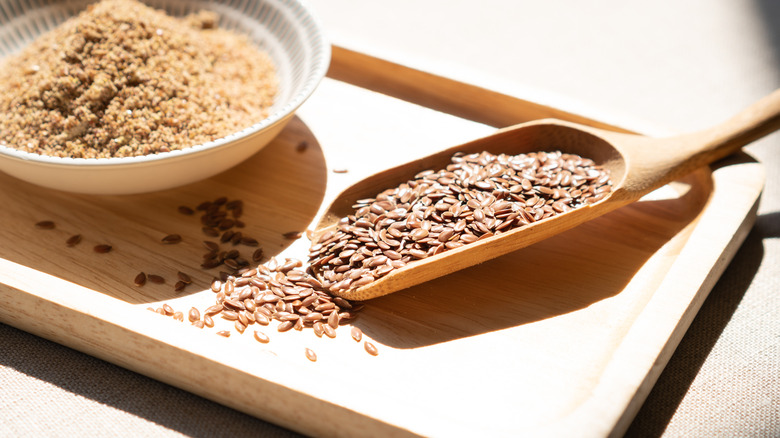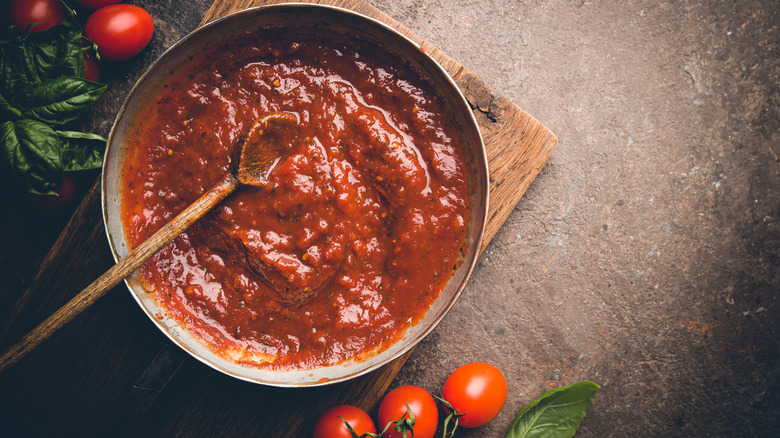The Absolute Best Substitutes For Cornstarch
Cornstarch is a chemical compound that is made through the process of wet-milling corn. Said to date back to the 1840s,it was used primarily in laundry detergent and was not considered edible (via Spiceography). Now, you are likely to find cornstarch in kitchens everywhere.
The neutral tasting white powder has numerous functions, but the most common use in the kitchen is as a thickening agent. According to The Spruce Eats, the chemical molecules in cornstarch absorb liquid and expand, causing the liquid to thicken. From sauces and soups to pie fillings and custards, this is a great staple to stock in your pantry. It's an essential ingredient for Chinese cooking and makes a great addition to batters and coating mixtures when frying foods, as it leads to an extra crispy texture.
For all its benefits, there are some downsides to using cornstarch. It is known to clump and change the color of a liquid, resulting in a cloudy appearance (via Our Everyday Life). The Spruce Eats also explains that cornstarch does not react well in highly acidic liquids, such as tomato-based sauces, as it breaks down and loses its thickening power. Some people also might have corn allergies or want to avoid a product made from a frequently genetically modified grain. If its not compatible with your diet or perhaps your stock is depleted, don't despair if it shows up on a list of ingredients for your next recipe. Instead, check out this is the list of the absolute best cornstarch substitutes and how to use them.
All-purpose flour
Though it may be more known for its use in batters and doughs, or as a coating agent when frying, all-purpose flour is also a common thickener. It is famously essential for making a roux, which is a cooked blend of starch and fat in equal parts. Flour can also be substituted in most recipes where cornstarch is indicated. Keep in mind that cornstarch and flour absorb liquid in different ways. If a recipe calls for cornstarch in thickening a sauce, Spoon University recommends using double the amount of flour for the same effect.
There are some benefits in using flour over cornstarch for certain thickening situations. According to The Spruce Eats, flour works better than cornstarch as a thickening agent for acidic sauces. Flour also doesn't lose its thickening power over time, so it would be a great choice for long-simmered sauces (via Taste of Home). Raw flour does have a distinct flavor that it can impart on sauces, so it is important to let the flour cook, such as in making a roux, to get rid of that starchy aftertaste.
Arrowroot powder
Arrowroot is a tuber native to South America, but is now grown throughout the tropics (via Britannica). When ground into a powder, this starch acts as a great thickener. Similar to cornstarch, it is neutral in flavor and a great substitute if you are trying to keep a recipe gluten free.
Using arrowroot as a thickener is similar to cornstarch in that you want to make a slurry by combining the powder and water before adding it to a sauce, which will prevent clumping. According to Bob's Red Mill, it is recommended to add the slurry towards the end of cooking a sauce or soup, as this starch does tend to break down with a longer cooking time. While Jessica Gavin notes that arrowroot powder doesn't lose its thickening power in acidic sauces, she warns that it does not mix well with dairy-based sauces and soups, as it can become slimy. Taste of Home recommends substituting arrowroot for cornstarch at a one-to-one ratio.
Potato starch
This white powder produced from extracting the starch from potatoes is another great substitute for cornstarch. According to Martha Stewart, potato starch offers a more appealing mouthfeel than cornstarch and results in a glossy finish when it comes to preparing sauces. It is also common substitution for cornstarch in pie fillings (via Bob's Red Mill). The Woks of Life also recommends using it in Chinese cooking, particularly for frying, although it can be used to thicken sauces such as stir-fry sauces. In fact, potato starch actually produces an even crispier texture in fried Chinese foods than cornstarch.
Potato starch, unlike cornstarch, can withstand high temperatures, but it cannot hold up through long cooking times. Similar to arrowroot powder, it is best added towards the end of cooking. Although potato starch and cornstarch can be interchanged at a one to one ratio, Martha Stewart recommends starting with less potato starch and adding more if necessary. Like other starches on this list, it should be incorporated into sauces and soups using the slurry method.
Another important thing to keep in mind: Potato flour, which is made from whole potatoes, is not the same as potato starch, and will not have the same effect.
Tapioca starch
If you are a fan of bubble tea, you may already be familiar with tapioca in the form of the little boba pearls at the bottom of your cup. Derived from the cassava root (also known as yuca), tapioca is a starch commonly used in tropical countries. It is gaining more traction in the United States being used to thicken sauces and soups, as well as pie fillings and custards.
Similar to the other tuber-based products on this list, tapioca starch will result in a glossy finish (via Spiceography). It is best when added late in the cooking process, and it can replace cornstarch in equal amounts. A huge benefit of using tapioca starch is that it keeps its thickening power for a long time. According to Food Network, tapioca starch results in a thick, velvety mouthfeel that will hold its quality over several days. It is no wonder it is quickly becoming a staple in kitchens everywhere. The Wok of Life recommends using tapioca starch in Chinese cooking for sauces and even marinades, noting that in China it is generally held in greater regard than cornstarch, as it has an even silkier feel.
Rice flour
Rice flour is made by milling rice into a fine powder. The version made with white rice has had the bran and germ removed from the grain, while brown rice flour has the whole grain intact (via RecipeTips.com). While not as commonly known as others on this list, rice flour can be a good substitute for cornstarch.
According to Leaf, since rice flour does not clump, you do not need to make a slurry if you're using it a thickener. Just add it to the liquid, and it will work almost immediately. It is recommended to use about 2 tablespoons of rice flour for every cup of liquid being thickened. White rice flour as well as glutinous rice flour tend to offer smoother results than brown rice flour, which provides a more granular mouthfeel. Our Everyday Life notes that rice flour does not impact the color of a liquid as cornstarch does, so it can be a great alternative when making something with a clear liquid.
Xanthan gum
If you have even dabbled in gluten-free baking, you have probably come across xanthan gum. Made by feeding carbohydrates to bacteria (a process that ferments glucose molecules), xanthan gum is a common food additive in gluten-free products, as it can provide structure in the absence of gluten (via Amazing Food Made Easy). While it is a common ingredient in store-bought salad dressings, it can also be used to thicken sauces.
It is easy to replace cornstarch with xanthan gum, as Club Gluten Free notes that it can be substituted in equal parts. It will work very quickly to thicken liquid and can be whisked directly into a sauce. Although you do not need to make a slurry, you can slow down the speed in which the white powder thickens a liquid by first mixing it with sugar, as that will dilute its absorption powers. On the same note, xanthan gum would not be the best choice for thickening something that has a lot of sugar, as it will take a long time to make that work.
Guar gum
Another common ingredient in gluten free baking, guar gum is made by milling the seeds of a plant grown in India (via Bob's Red Mill). Similarly to xanthan gum, the powder provides much needed structure to gluten-free products, but it is also a handy thickening agent. Unlike many options on this list, guar gum is not affected by temperature. You can add it to hot and cold liquids and get the result you want. It does take a few minutes for guar gum to hydrate and has a tendency to clump, so Whole Grain 100 recommends that you whisk it vigorously into a liquid. Heat will help speed up the thickening process.
Since the thickening power of guar gum is eight times that of cornstarch, it should be used sparingly. For hot liquids such as soups and sauces, you only want to use one to three teaspoons per quart of liquid.
Ground flaxseed
Ground flaxseed or flax meal is made by processing flaxseed into a flour-like substance. According to Leaf, you can even make this at home using whole flaxseeds if you own a coffee grinder. Though it may be an unexpected alternative to cornstarch, ground flaxseed is an interesting substitute when making a roux, offering a nutty aroma and flavor. If you do not mind its subtle flavor, this might be a good choice for you. It also has a darker color, so it may not be the best alternative in a sauce where you want a clear, white appearance.
Another downside: Ground flaxseed has relatively weak thickening power, needing two times the amount of flour or four times the amount of cornstarch in a recipe (via Leaf). However, it offers welcome nutritional benefits — not only is it a high-fiber food, it's full of omega-3 fatty acids (via Heal with Food). You can also thicken soups and sauces with ground flaxseed by gradually mixing into a liquid that is at a boil without having to make a roux or a slurry.
Thickening a Sauce without starch
All of the previous suggestions for replacing cornstarch involve some other starchy substance that plays a similar role. What happens if you do not have any of these alternatives on hand or you just don't want to use a starch in your dish? There is, in fact, a way to thicken sauces and soups without a starch. These starchy powders work as thickening agents because they absorb liquid. In some cases you can eliminate this step by reducing liquid naturally. This works particularly well for tomato-based sauces.
According to Allrecipes, simply bring your liquid to a boil and then take the heat down to low to maintain a simmer. Allow the liquid to reduce until it reaches your desired consistency. You can check the thickness of the sauce using a spoon. If it coats the back of a spoon, it has reduced enough. Unfortunately, this method is time consuming and will not work in all situations in which cornstarch is used, but with a little patience, you can get the desired result in some sauces and soups.
